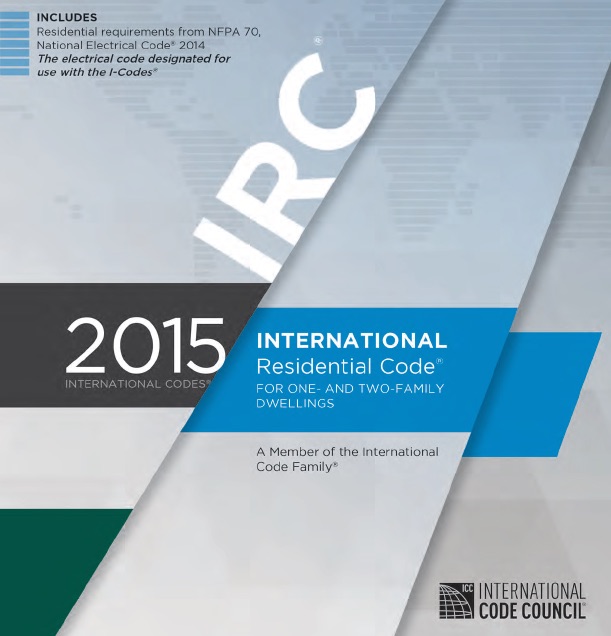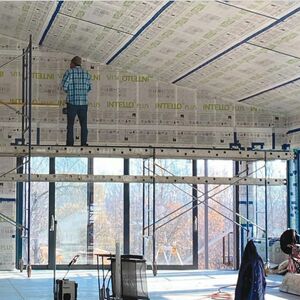
Image Credit: International Code Council
Building codes, especially those related to energy efficiency, have improved a lot over the years. With building enclosures, this has made a big difference. We now have more insulation, less thermal bridging, and tested air barriers. On the mechanical side, the improvements are significant — reduced duct leakage and mechanical ventilation in airtight homes — but there’s still a gap between some code requirements and what’s being installed.
But that gap isn’t my focus today. Instead I’ll spell out what those HVAC design requirements are. But first, let me say a little about how building codes work. At the highest level are the model codes. The major player in this arena is the International Code Council (ICC), and I’ll focus on two of their codes that include HVAC design requirements for homes: the International Residential Code (IRC) and the International Energy Conservation Code (IECC). Of course, when you build a home, you’ll have to meet the requirements of your local building department, which probably uses one of the I-codes, perhaps with some modifications.
On the topic of HVAC design, the IRC has more detail than the IECC, as you might expect. Also, the IECC just repeats some of the major requirements from the IRC.
Equipment sizing
Both the IRC and the IECC say the same thing here:
Equipment sizing and efficiency rating (Mandatory). Heating and cooling equipment shall be sized in accordance with ACCA Manual S based on building loads calculated in accordance with ACCA Manual J or other approved heating and cooling calculation methodologies. New or replacement heating and cooling equipment shall have an efficiency rating equal to or greater than the minimum required by federal law for the geographic location where the equipment is installed.
That’s section N1103.7 in the IRC and R403.7 in the IECC, and it’s exactly the same in both the 2015 and 2018 codes. The main alternative to the ACCA Manual J load calculation protocol would be to use the ASHRAE Handbook of Fundamentals.
In plain English, this requirement simply means that heating and cooling systems in homes have to be sized according to approved protocols. That’s Manual J from the Air Conditioning Contractors of America (ACCA) for calculating the heating and cooling loads of the house and Manual S, also from ACCA, for determining the capacity of the equipment needed to meet those loads. (A little reminder: Loads and capacity are different things. The former tells you what the building needs; the latter tells you what the equipment supplies.)
Duct design
Getting the home’s heating and cooling loads (Manual J) are the first step. Figuring out what equipment capacity to use (Manual S) is the second step. Some contractors go that far and then revert to rules of thumb for one of the most critical steps: designing the distribution system. If you’re going with an air distribution system (as opposed to hydronic), getting the proper air flow is critical. Here’s what the IRC says:
M1601.1 Duct design. Duct systems serving heating, cooling and ventilation equipment shall be installed in accordance with the provisions of this section and ACCA Manual D, the appliance manufacturer’s installation instructions or other approved methods.
This is the same in both the 2015 and 2018 versions. I wrote a multi-part explanation of the Manual D process last year, explaining how the available static pressure, total effective length, and friction rate determine the duct sizes you need to use to get the right air flow.
The IRC has a lot of other requirements for duct design, too. For example, it allows the use of stud or joist cavities in walls and floors to be used for return air but not supply air (M1601.1.1). And it’s forbidden to supply conditioned air to a garage using the same system that supplies conditioned air to the living spaces (M1601.6). (That last one is a big no-no that can easily contaminate the indoor air with pollutants from the garage or carbon monoxide created by backdrafting a water heater.)
Whole-house mechanical ventilation
Airtight homes need mechanical ventilation. Building scientists have known this for a long time. Now it’s in the building codes. I don’t know when it first showed up, but it’s been in the IRC at least since 2012. Here’s how it’s stated in the 2018 IRC:
R303.4 Mechanical ventilation. Where the air infiltration rate of a dwelling unit is 5 air changes per hour or less where tested with a blower door at a pressure of 0.2 inch w.c (50 Pa) in accordance with Section N1102.4.1.2, the dwelling unit shall be provided with whole-house mechanical ventilation in accordance with Section M1505.4.
Georgia has been subject to this requirement for several years now, ever since we went on the 2012 IRC. We also require homes to have an airtightness of less than 7 ACH50. That means some builders have been aiming for what they see as the “sweet spot” of less than 7 ACH50 but greater than 5 ACH50. They meet both the IRC and IECC requirements for Georgia that way and aren’t required to add mechanical ventilation. (We’re still on the 2009 IECC here.)
The good news for whole-house ventilation afficionados is that the airtightness requirements in the 2015 and 2018 IECC eliminate that “sweet spot.” The maximum air leakage allowed in IECC climate zones 1 and 2 is 5 ACH50 and in climate zones 3 through 8 is 3 ACH50. (That’s in section R402.4.1.2 of the 2015 & 2018 IECC.)
Sections N1103.6 and M1505 in the IRC have some other requirements for ventilation, too. Here are a few highlights:
- Mechanical ventilation fans have to meet minimum efficacy levels in cfm/watt. (N1103.6.1)
- If the air handler is the main fan for the whole-house ventilation system, the blower has to be powered by and electronically-commutated motor. (N1103.6.1)
- The ventilation rate required in the 2018 IRC is calculated by the familiar equation: Rate = (0.01 x conditioned floor area) + [7.5 x (number of bedrooms +1)]. That’s the basic equation from the 2010 version of the ASHRAE 62.2 standard. (M1505.4.3)
Getting into the code is the first step…
These things are a good first step. But there are a couple of other critical steps that have to follow. First, the IRC and IECC have to be adopted by states and local jurisdictions. I’ve been involved in the push to get Georgia to move to the 2015 IECC, and it’s not a fun process. We spent almost a year working through the issues, compromising on some of the items, and then getting the whole thing delayed another two years.
And second, there’s enforcement. Building code officials have their hands full, and the majority of them don’t have the time or the resources to learn what they need to know to understand the reports they get. Some don’t bother with Manual J, S, and D reports at all. Some put forth a good effort but don’t know enough about what to look for in the reports.
Once they get adopted into the local codes and building officials start enforcing them, HVAC design requirements in the code are kind of like locks on doors. They won’t keep criminals out. They’re just there to guide the honest folks in the industry. My hope is that we’re going to get to a point where the pressure to do things the right way will break through the activation barrier. That pressure is coming from a number of directions: the Internet, building codes, and green building programs, especially.
Allison Bailes of Decatur, Georgia, is a speaker, writer, building science consultant, and the author of the Energy Vanguard Blog. You can follow him on Twitter at @EnergyVanguard.
Weekly Newsletter
Get building science and energy efficiency advice, plus special offers, in your inbox.















0 Comments
Log in or create an account to post a comment.
Sign up Log in